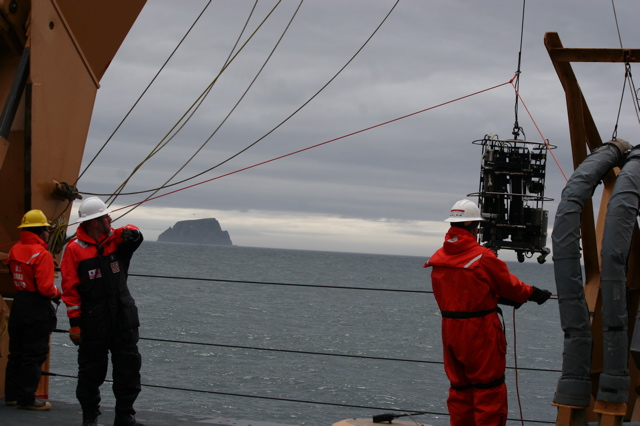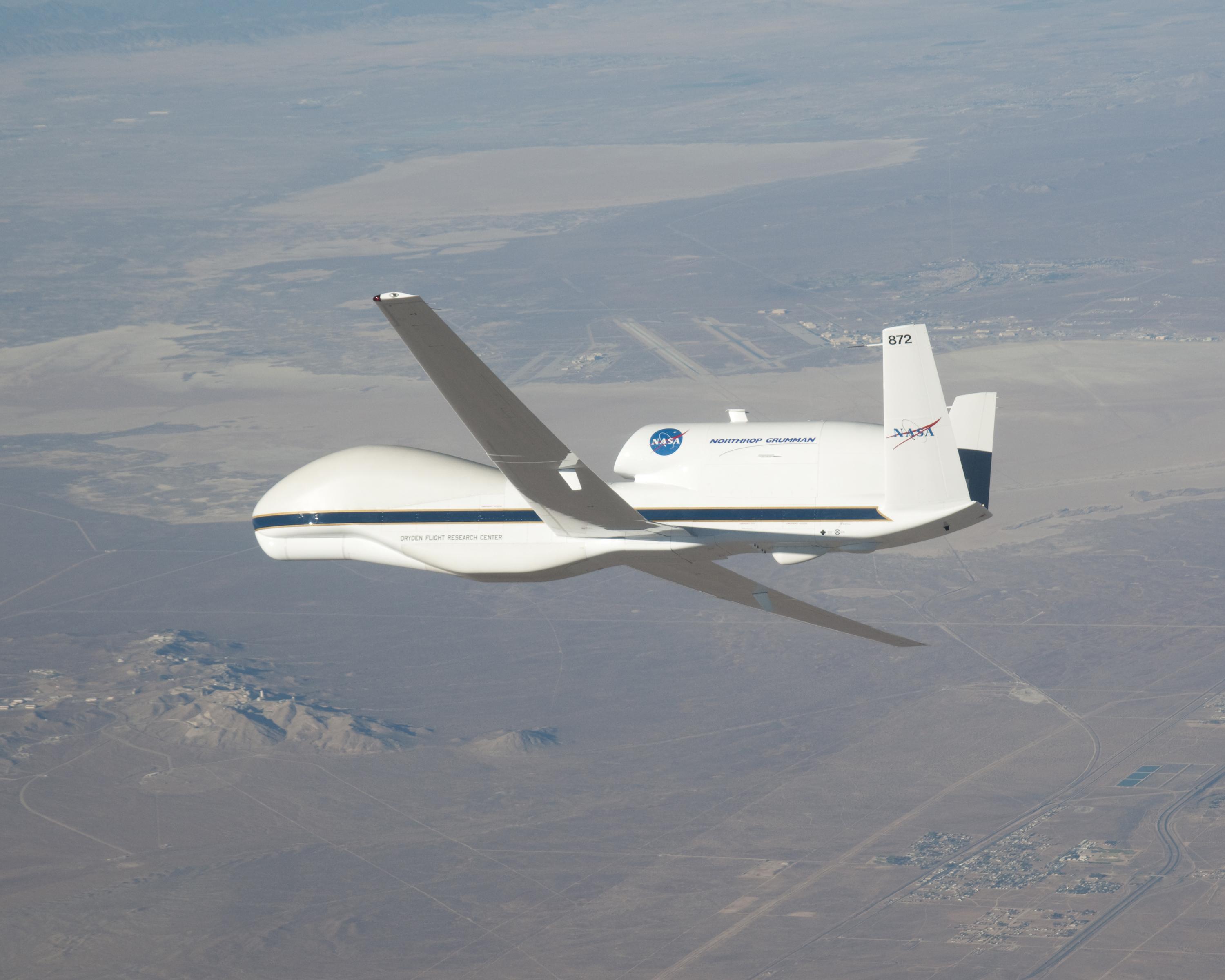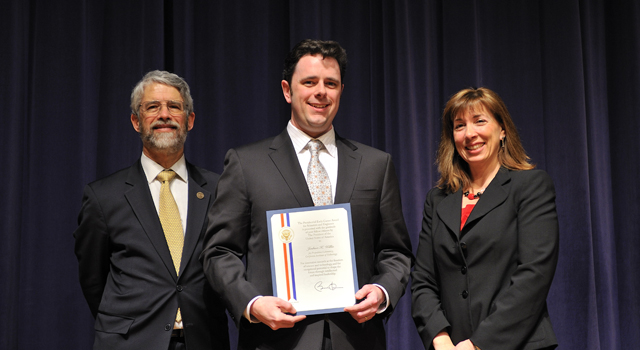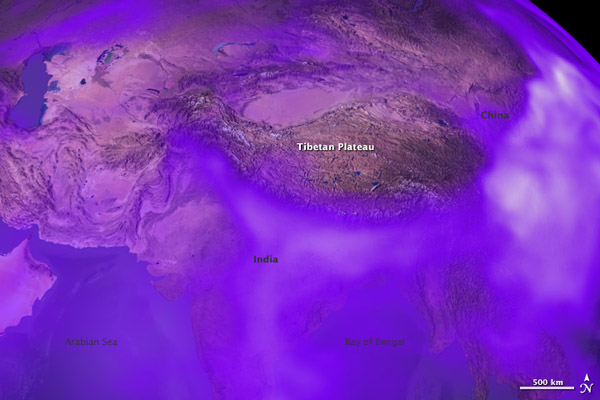Guest science writer KarenRomano Young reports from the ICESCAPEmission:

The U.S. Coast Guard Cutter Healy, our chunky red-and-white icebreaker, sits at the gates of the Arctic Ocean. In the wee hours this morning, the sun set and quickly rose again, and a rainbow stretched up into low clouds. The ICESCAPE mission had reached station 5 of a seven-stop transect of the Bering Strait, between Fairway Rock — resembling Kong Island, but with pointy ears — and Little Diomede (U.S.) — something like the “Cliffs of Insanity” in The Princess Bride. Close by is Big Diomede (Russia), topped with fog.
Movie references aside, this is a dramatic spot in which to find yourself when you wake up in the morning — or in the evening, as is the case for the half of the science crew working the night shift to process the samples.
It seems that no matter how many times a scientist has been to sea, it doesn’t get old. Greg Mitchell (below right), a specialist in ocean optics from the Scripps Institution of Oceanography, reckons he has spent about four years of his life aboard ships. His first trip to the Arctic was in 1987, his first year at Scripps. Mitchell’s research has taken him all over the world — to Antarctica and back again many times — but he hasn’t been inside the Arctic Circle since 1989. He expects change. 
Observing the system…..and how it interacts with the edge of the sea ice…..and what’s going on with the ice melt…..and how it affects the ocean…..those principles won’t be any different than they were 20 years ago. “What we’re clearly seeing is that the sea ice is reducing more and more all the time,” said Mitchell. “This means less sunshine reflecting off the ice back into space, and more getting into the ocean.”
He expects the increase in sun-light on the sea to do three things:
- “The light that’s not reflected will heat the ocean, accelerating the warming and accelerating the melting of the sea ice.”
- “As the ocean warms it becomes more stratified. If you dive in a lake in the summertime, it’s warmer at the surface. But as you dive down, you feel the cold. That’s because the warm water is lighter than the cold water, and it stays at the surface. That’s thermal stratification. As you warm the ocean, it’ll stratify more and that will create a warm layer with a lot of light for algae to bloom (as long as they have nutrients).”
- “More light in the ocean should cause more total photosynthesis in the Arctic, so we’ll lose habitat for polar bears but we’ll gain habitat for plankton.”
Like the rest of us, Mitchell is concerned about that. “I’m not saying it’s a good trade off. I think we should leave things alone. But the system’s changing, and as it changes we don’t know what the consequences of those changes will be. It’s hard to say what we could do. What we really need to do is to find a way for humans to have smaller footprint on earth. So we need to understand the processes better and then we need to model it.”
That’s why he’s here.
Mitchell, along with his group from Scripps, is involved in ground-truthing the optical properties of the Arctic Ocean (photos at the top and bottom of this post). That is, he’s helping to ensure that what they see at the surface squares up with the methods NASA satellites use to assess ocean color, an indicator of the level of chlorophyll and, by proxy, phytoplankton. NASA’s satellites measure the color of the ocean by flying over the earth and picking up blue, blue green, and green. If there’s not a lot of algae, the ocean is blue. If there is a lot of algae, the ocean is green.
But color is just one way of looking at phytoplankton levels. In order to truly assess the situation — for example how much carbon dioxide the phytoplankton are taking in – scientists need to assess the processes at work in the sea. “The optics don’t tell us this, so we have to take water samples, process the water, and then relate that to the optics we measure from the ship,” Mitchell said.
The global mapping you can see on the NASA site uses mathematical equations developed from the shipboard work. Satellite validation and calibration is based on the findings of scientists who go to sea and study the water to see what’s living there. Mitchell’s research group claims responsibility for about 20 percent of the global observations used by NASA for their models to convert satellite-measured optical measurements to chlorophyll estimates.

The data contributes to models that allow prediction of primary production — the growth and health of organisms — under various conditions. Mitchell’s instruments include a small optical profiler — a fish-shaped instrument lowered from the Healy’s bow — and an optical package of instruments that measure water properties when it is lowered from the powerful A-frame at the stern.
“As ecologists, we don’t want to just know what color the ocean is,” he said. “We want to know how much plankton there is.” He walks to the edge of the ship and looks over the rail. “Now what we’re seeing out here is green water. There’s a lot of chlorophyll.” That means a strong pulse of phytoplankton, busy photosynthesizing the extra sunlight.
All photos shot by and courtesy of Karen Romano Young







